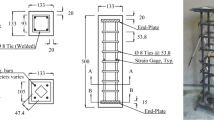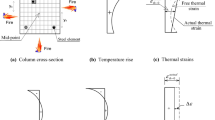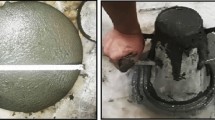Abstract
Full-scaled model columns were placed both in summer and winter with an ultra-high strength concrete with a compressive strength more than 150 MPa, and stress distribution and cracking were experimentally evaluated. Specimens placed in summer exhibited cracks around the steel reinforcements which sometimes joined together. Specimens placed in winter showed, in addition to the cracks around the reinforcement, an internal crack perpendicular to the column axis as well as at the specimen surface. These cracks were found to be dependent on the temperature history due to hydration heat liberation and associated autogenous shrinkage strains. It was shown that the autogenous shrinkage of concrete increased when temperature after mixing was low and the maximum temperature during temperature history was high. This accounts for the numerous cracks found in the specimen placed in winter. Strain perpendicular to the axial direction was smaller than that of the axial direction implying the tensile stress due to autogenous shrinkage acting perpendicular to the axial direction as far as the autogenous shrinkage is isotropic. Finite element analysis confirmed the lateral stress due to autogenous shrinkage. Possible influences of autogenous shrinkage of ultra-high strength concrete on the structural performance include (1) early spalling of cover concrete and degradation of flexural strength, (2) degradation of bond and shear strength, and (3) prospect of longitudinal crack in center of the column and degradation of flexural strength.
























Similar content being viewed by others
References
Bentur A, Igarashi S, Kovler K (2001) Prevention of autogenous shrinkage in high-strength concrete by internal curing using wet lightweight aggregates. Cem Concr Res 31:1587–1591
CEB-FIP (1991) Model code 1990, Thomas Telford
Collins MP, Mitchell D, MacGregor JG (1993) Structural design considerations for high-strength concrete. Concr Int 15:27–34
Ito H, Maruyama I, Tanimura M, Sato R (2004) Early age deformation and resultant induced stress in expansive high strength concrete. J Adv Concr Technol 2:155–174
Japan Concrete Institute (2008) Guidelines for control of cracking of mass concrete. JCI, Tokyo
Jensen OM, Hansen PF (1999) Influence of temperature on autogenous deformation and relative humidity change in hardening cement paste. Cem Concr Res 29:567–575
Jensen OM, Hansen PF (2001) Water-entrained cement-based materials: I. Principle and theoretical background. Cem Concr Res 31:647–654
Katayose N, Takamori N, Nishida H, Teraoka M (2006) Mechanical properties and autogenous shrinkage behavior of high strength concrete at early age. Proc Jpn Concr Inst 28:497–502 (in Japanese)
Kovler K, Jensen OM (2007) Internal curing of concrete, State-of-the-art report of RILEM technical committee 196-ICC, Report 41
Lura P, van Breugel K, Maruyama I (2001) Effect of curing temperature and type of cement on early-age shrinkage of high performance concrete. Cem Concr Res 31:1867–1872
Lura P, Jensen OM, Weiss J (2009) Cracking in cement paste induced by autogenous shrinkage. Mater Struct 42:1089–1099
Maruyama I, Sato R, Suzuki M (2005) Verification of soundness of HPC in RC members. Summaries of technical papers of annual meeting, Architectural Institute of Japan, 2005.9, Osaka, PP 625–626 (in Japanese)
Maruyama I, Kameta S, Suzuki M, Sato R (2006) Cracking of high strength concrete around deformed reinforcing bar due to shrinkage. In: Kovler K (ed) International RILEM-JCI seminar on concrete durability and service life planning, RILEM Publications S. A. R. L., Ein-Bokek, pp 104–111
Murata Y, Kurihara M, Yagenji A, Kaminosono T, Hiraishi H (1991) Vertical split of high-strength RC columns. Summaries of technical papers of annual meeting, Architectural Institute of Japan, Osaka, Structures II, pp 155–156 (in Japanese)
Paillere AM, Buil M, Serrano JJ (1989) Effect of fiber addition on the autogenous shrinkage of silica fume concrete. ACI Mate J 86:139–144
Sato R, Tanaka S, Hayakawa T, Tanimura M (1999) Experimental studies on reduction of autogenous shrinkage and its induced stress in high strength concrete. In: Proceedings of the 2nd international research seminar on self-desiccation and its importance in concrete technology, Lund, pp 163–171
Schrage I, Mangold M, Sticha J (1992) An approach to high-performance concrete in Germany. In: Fourth CANMET/ACI international conference on fly ash, silica fume, slag, and natural pozzolans in concrete, Istanbul, Supplementary Papers, pp 493–511
Suzuki M, Nakase H, Maruyama I, Sato R (2005) Effect of temperature on self-stress of expansive ultra high strength concrete. Cem Sci Concr Technol 59:375–382 (in Japanese)
Suzuki M, Maruyama I, Amacho S, Sato R (2006) A Study on deformation and resultant induced stress in expansive-ultra high strength concrete. Proc Jpn Concr Inst 28:563–568 (in Japanese)
Suzuki M, Maruyama I, Nakase H, Sato R (2009) Reduction of self-induced stress and resultant cracks in reinforced ultra high-strength concrete column by dosage of expansive additive and shrinkage reducing agent. J Struct Constr Eng Trans AIJ 635:1–10 (in Japanese)
Tazawa E, Miyazawa S (1992) Autogenous shrinkage caused by self-desiccation in cementitious material. In: 9th international congress on the chemistry of cement, New Delhi vol 4, pp 712–718
Tazawa E, Miyazawa S (1995) Experimental study on mechanism of autogenous shrinkage of concrete. Cem Concr Res 25:1633–1638
Tazawa E, Matsuoka S, Miyazawa S, Okamoto S (1994) Effect of autogenous shrinkage on self stress in hardening concrete. In: International RILEM symposium on thermal cracking in concrete at early ages, Munich, pp 221–228
Tsutsui H, Sato R, Xu M (1996) A study on stress due to autogenous shrinkage in high-strength concrete. JCA Proc Cem Concr 50:478–483 (in Japanese)
Author information
Authors and Affiliations
Corresponding author
Rights and permissions
About this article
Cite this article
Maruyama, I., Suzuki, M. & Sato, R. Stress distribution and crack formation in full-scaled ultra-high strength concrete columns. Mater Struct 45, 1829–1847 (2012). https://doi.org/10.1617/s11527-012-9873-7
Received:
Accepted:
Published:
Issue Date:
DOI: https://doi.org/10.1617/s11527-012-9873-7




